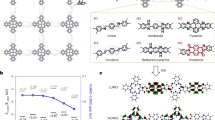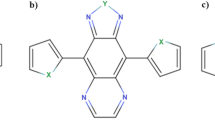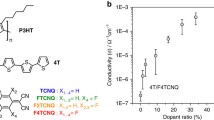Abstract
Charge-transfer complexes (CTCs) of small π-conjugated organic molecules have been studied for a long time as organic semiconductors and conductors. However, the formation of such complexes between two π-conjugated macromolecules, namely, conjugated polymers has only recently been discovered. In this work, the formation of such CTCs is theoretically considered and their specific features in comparison with low-molecular CTCs are revealed. In particular, it is shown that the energy gap (optical gap) of the CTC of conjugated polymers can be significantly narrower and the charge transfer can be higher than those in their low-molecular analogs (even at the same energies of the highest occupied molecular orbital of a donor and the lowest unoccupied molecular orbital of an acceptor), which is explained by charge delocalization along a polymer chain. This finding is most pronounced in the case of ladder-type polymers, the charge delocalization in which has a quasi-two-dimensional character. Density functional theory calculations of CTC fragments of two ladder-type conjugated polymers confirm the theoretical assumptions, emphasizing the prospects of using such complexes in organic electronic devices. Based on the results obtained, we propose to create and study a new type of CTC using higher-dimension structures, e.g., two-dimensional sheets or three-dimensional conductive frameworks.




Similar content being viewed by others
REFERENCES
R. S. Mulliken, J. Am. Chem. Soc. 74, 811 (1952).
G. Saito and Y. Yoshida, Bull. Chem. Soc. Jpn. 80, 1 (2007).
H. Jiang, P. Hu, J. Ye, K. K. Zhang, Y. Long, W. Hu, and C. Kloc, J. Mater. Chem. C 6, 1884 (2018).
A. A. Bakulin, D. S. Martyanov, D. Y. Paraschuk, M. S. Pshenichnikov, and P. H. M. van Loosdrecht, J. Phys. Chem. B 112, 13730 (2008).
A. Yu. Sosorev and D. Y. Paraschuk, Isr. J. Chem. 54, 650 (2014).
O. D. Parashchuk, T. V. Laptinskaya, and D. Y. Paraschuk, Phys. Chem. Chem. Phys. 13, 3775 (2011).
A. Yu. Sosorev and S. Zapunidi, J. Phys. Chem. B 117, 10913 (2013).
A. Yu. Sosorev, O. D. Parashchuk, S. A. Zapunidi, G. S. Kashtanov, I. V. Golovnin, S. Kommanaboyina, I. F. Perepichka, and D. Yu. Paraschuk, Phys. Chem. Chem. Phys. 18, 4684 (2016).
O. D. Parashchuk, S. Grigorian, E. E. Levin, V. V. Bruevich, K. Bukunov, I. V. Golovnin, T. Dittrich, K. A. Dembo, V. V. Volkov, and D. Y. Paraschuk, J. Phys. Chem. Lett. 4, 1298 (2013).
D. T. Duong, C. Wang, E. Antono, M. F. Toney, and A. Salleo, Org. Electron. 14, 1330 (2013).
K. Xu, H. Sun, T. P. Ruoko, et al., Nat. Mater. 19, 738 (2020).
A. A. Bakulin, A. Rao, V. G. Pavelyev, P. H. M. van Loosdrecht, M. S. Pshenichnikov, D. Niedzialek, J. Cornil, D. Beljonne, and R. H. Friend, Science (Washington, DC, U. S.) 335, 1340 (2012).
S. Haseena and M. K. Ravva, J. Electron. Mater. 50, 1621 (2021).
A. Yu. Sosorev, D. Yu. Godovsky, and D. Yu. Paraschuk, Phys. Chem. Chem. Phys. 20, 3658 (2018).
J. Lee, A. J. Kalin, T. Yuan, M. Al-Hashimi, and L. Fang, Chem. Sci. 8, 2503 (2017).
A. Yu. Sosorev, Mater. Des. 192, 108730 (2020).
A. Yu. Sosorev, Phys. Chem. Chem. Phys. 19, 25478 (2017).
M. Yu. Lavrentiev, W. Barford, S. J. Martin, H. Daly, and R. J. Bursill, Phys. Rev. B 59, 9987 (1999).
L. Zhu, Y. Yi, A. Fonari, N. S. Corbin, V. Coropceanu, and J.-L. Brédas, J. Phys. Chem. C 118, 14150 (2014).
M. W. Schmidt, K. K. Baldridge, J. A. Boatz, S. T. Elbert, M. S. Gordon, J. H. Jensen, S. Koseki, N. Matsunaga, K. A. Nguyen, S. Su, T. L. Windus, M. Dupuis, and J. A. Montgomery, Jr., J. Comput. Chem. 14, 1347 (1993).
M. S. Gordon and M. W. Schmidt, in Theory and Applications of Computational Chemistry: The First Forty Years, Ed. by C. E. Dykstra, G. Frenking, K. S. Kim, and G. E. Scuseria (Elsevier, Amsterdam, 2005), p. 1167.
A. Babel and A. Jenekhe, J. Am. Chem. Soc. 125, 13656 (2003).
S. Fratini, M. Nikolka, A. Salleo, G. Schweicher, and H. Sirringhaus, Nat. Mater. 19, 491 (2020).
T. Mueller and E. Malic, npj 2D Mater Appl. 2, 29 (2018).
Y. Garcia-Basabe, A. R. Rocha, F. C. Vicentin, C. E. P. Villegas, R. Nascimento, E. C. Romani, E. C. de Oliveira, G. J. M. Fechine, S. Li, G. Eda, and D. G. Larrude, Phys. Chem. Chem. Phys. 19, 29954 (2017).
H. Fang, C. Battaglia, C. Carraro, S. Nemsak, B. Ozdol, J. S. Kang, H. A. Bechtel, S. B. Desai, F. Kronast, A. A. Unal, G. Conti, C. Conlon, G. K. Palsson, M. C. Martin, A. M. Minor, et al., Proc. Natl. Acad. Sci. U. S. A. 111, 6198 (2014).
S.-H. Shin, H.-J. Noh, Y.-H. Kin, Y.-K. Im, J. Mahmood, and J.-B. Baek, Polym. Chem. 10, 4185 (2019).
Funding
This work was supported by the Presidential Grants Council of the Russian Federation (presidential grant no. SP-6048.2021.1).
Author information
Authors and Affiliations
Corresponding author
Ethics declarations
The author declares that he has no conflicts of interest.
Additional information
Translated by K. Shakhlevich
Rights and permissions
About this article
Cite this article
Sosorev, A.Y. Charge-Transfer Complexes of Linear and Ladder-Type Conjugated Polymers as Promising Organic Narrow-Gap Semiconductors. J. Exp. Theor. Phys. 135, 100–106 (2022). https://doi.org/10.1134/S106377612207007X
Received:
Revised:
Accepted:
Published:
Issue Date:
DOI: https://doi.org/10.1134/S106377612207007X




